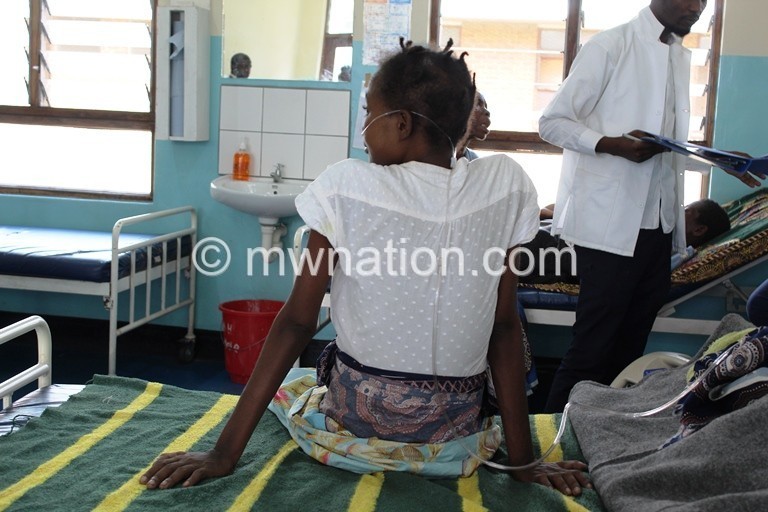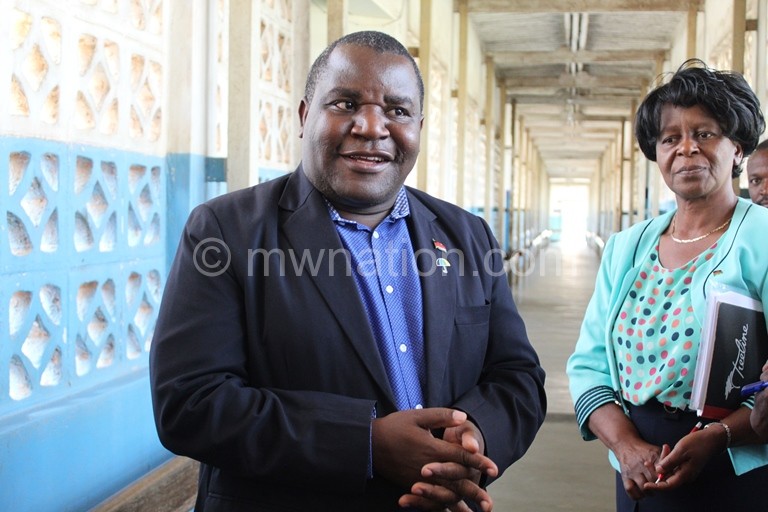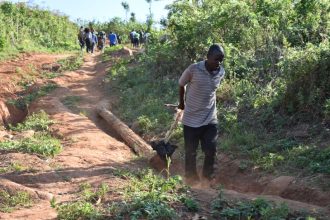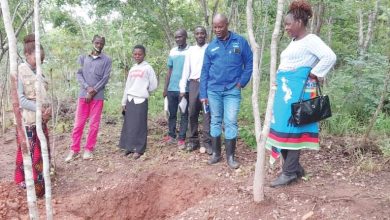Stopping Aids before it kills
It is 11.20am when we venture into the snaky corridors of Nsanje District Hospital, formerly a refugee camp for Mozambicans who fled civil war in the 1970s.
It is sweltering in the border district’s largest health facility, where a tuberculosis patient concealed as Moira is readmitted to the emergency bay of a newly refurbished female ward.

The 36-year-old is one of nearly 400 patients with advanced HIV treated at the facility since she was first admitted in January. Some health workers fear the count may exceed the 500 treated between July 1 2017 and December 31 2018. To them, the caseload exposes a gap in the national agenda to end Aids-related deaths.
‘I’ve gone through a lot’
Long-serving staff remembers an era of mourning—2006 to 2017—when about a third of inpatients with conditions related to HIV were dying amid lengthy delays in diagnosis and treatment of advanced HIV. The condition is usually characterised by deadly opportunistic diseases that get worse as immunity falls, evoking images from the turn of the millennium when Aids was terminating five times the lives it claims nowadays.

The sights have become sporadic since the country liberalised access to antiretroviral (ARVs) in 2005. National Aids Commission (NAC) reports that free ARVs for all have slashed Aids-related deaths from 64 200 to 13 000 in the past 15 years.
UNAids estimates show nearly 17 000 people with HIV die every year.
However, Moira’s debilitating loss of weight personifies lapses in ensuring every HIV positive person takes life-prolonging drugs consistently until the virus becomes undetectable and unlikely to be transmitted.
“I’ve gone through a lot,” she states. “I was forced to taking the drugs because I could go a day or so without food. I couldn’t take the drugs on a flat stomach. One needs adequate nutritious food for the drugs to work.”
When she was diagnosed with TB at Bangula Health Centre, the mother-of-three and her family were among 3.3 millions Malawians in need of urgent food aid following severe drought and pest attacks.
She explains: “I was sickly and frail. By August, I started experiencing chest pains, coughing out thick stuff and perspiring at night.
“A clinician at Phokera Health Centre referred me to Bangula, where they further referred me to Queen Elizabeth Central Hospital (Qech) in Blantyre after they detected advanced TB.”
Easily forgotten
Moira first arrived at Nsanje District Hospital six months ago on return from the Southern Region’s largest referral hospital. Her three sisters have been taking turns to ensure she receives adequate care.
“After taking the TB drugs, she briefly got better. However, coughing recurred and her face started swelling. We rushed to Qech for tests, got some new drugs and came straight here,” says Maria Medisoni, her guardian.
The long travels and hospital stays worsen poverty among people with HIV and their guardians. Bringing vital services closer to where they live lessens their financial hardship in fulfillment of the universal health coverage (UHC) policy.
Dr Andrew Likaka, director of quality management and UHC in the Ministry of Health, urges government and its partners to invest more in community-level initiatives to improve quality of care of patients with HIV even in hard-to-reach areas.
He states: “Being at the tail end of the country, it is very easy for border districts such as Nsanje to be forgotten even though this is where the best results and impacts are happening.
“It puzzles me that more donors concentrate on the capital, Lilongwe, and surrounding areas. If you tell them to extend their programmes to Nsanje, they think twice.”
He reckons Malawi has made a tremendous progress in the global push to ensure 90 percent of all people living with HIV know their status, 90 percent of all diagnosed with HIV are put on treatment and 90 percent of all people on ARVs achieve suppressed viral load.
Closing the gaps
At the United Nations, UNAids’ dashboard of the country’s progress towards 90-90-90 goals shows that an astonishing 91 percent know their status, 83 of those diagnosed with HIV started taking ARVs and 90 percent of them have undetectable viral load.
But the refurbished ward Moira occupies was a dilapidated monument of neglect just three years ago. Patients were often stretchered into the ward after enduring a long search for accurate diagnosis and treatment for opportunistic infections. Medcins Sans Frontiers (MSF-Belgium) bankrolled the rehabilitation of the ward and the installation of the rapid assessment unit at the hospital.
Despite this progress, HIV remains the leading killer among adults—causing nearly 17 000 deaths a year.
According to the world Health Organisation (WHO), the decrease in Aids-related deaths has stagnated.
Still, many patients are at risk of being left behind in national efforts to end Aids-related deaths, including the universal access to ARVs.
MSF country representative Ilse Casteels says the country needs to intensify efforts to end deaths from conditions catalysed by advanced HIV.
“Despite the impressive strides, challenges remain as 21.7 percent of HIV patients still don’t know their status and a significant number of patients has interrupted their treatment and are lost to follow up. Other patients are failing on treatment, but only low proportion of them has been switched to the second line ARV,” she explains.
In Nsanje, MSF is working closely with the district health office to improve the circle of care.
They have deployed community health promoters who sensitise patients to swiftly seek medical assistance when they sense danger signs. They have also equipped health centres to screen patients for infection associated with dwindling immunity.
“If necessary, the patients are referred to the hospital,” says Brains Kamanula, one of the counselors credited with inroads to stop advanced HIV at community level.
When patients and guardians arrive at Nsanje District Hospital, Kamanula chats with them to assess “red flags”. For Moira and her colleagues, the initial patient assessment involves ticking a checklist.
He explains: “When we met, she ticked all the boxes when it comes to knowledge about HIV and how to take ARVs, but her nutrition was not OK. She was receiving minimal care and support.
“Being financially constrained, the husband was usually away from home, doing piecework to source food and other basic needs,” he explained. Unfortunately, she was lost to follow up because the family has no phone,”
Kamanula and his fellow community health promoters conduct community outreach meetings and door-to-door visits to publicise the importance of taking ARVs without fail and going to hospital when the sense danger signs.
“If a patient adheres to drugs, the virus is suppressed and the immunity improves, so one can be healthy like any other person. In her case, she presented late with TB. That’s why we referred her to QECH,” he explains.
Left behind
However, some people are not reaping the benefits of the country’s test-and-treat because they either interrupted antiretroviral treatment or they take drugs intermittently.
Apart from nutritional gaps, some people living with HIV are forced to quit treatment by faith healers who misconstrue suppressed viral load and restored immunity for cure.
A man diagnosed with HIV at Ndamera Health Centre on the border between Malawi and Mozambique seven years ago bemoaned long trips to replenish the drugs, saying it can be costly for poor families.
He started taking ARVs when a daily dose entailed a handful of tablets per day. Now, one takes just a pill day, with the Ministry of Health already planning to introduce a fast-acting pill by January 2020.
NAC spokesperson Karen Msiska credits the current pill for reducing default rates and improving the outcome of the new strategy of ensuring everyone diagnosed with the virus is put on treatment immediately.
“Currently, the default rate in the country is
[estimated]at less than two percent. This includes those who transfer from one centre to another without proper documentation, deaths that are not properly documented as well as those who literally stop ARVs,” he says.
However, the drop-out rate is much higher in some districts, including Ntcheu, where district ART coordinator Davie Muhasuwa recently reported that nearly 40 percent of those on treatment can no longer be traced.
This increases the likelihood of advanced HIV and slows the pace towards achieving the 90-90-90 goal to combat Aids.
“ARVs help reduce the spread and impact of HIV in communities, so it is disheartening that some patients are defaulting. This is a setback towards the attainment of the HIV initiative,” says Lyness Soko, Malawi Network of People Living with HIV (Manet+) resource mobilisation and advocacy officer.
A long way to go
Besides raising mass awareness to stop HIV-related conditions before they get out of hand, MSF has embarked on a mentorship programme in some sites to improve the competences of the clinical staff.
Nsanje district medical officer Dr Alfonsina Ndembera put the interventions in context: “The mentorship programme and rapid assessment unit integrated into our emergency unit has improved our capacity to promptly diagnose patients with advanced HIV and put them on treatment.
“Most of patients arrive in a critical state, often with a host of infections that we have to treat before we put them back on a second line of ARVs. Treatment is nothing unless we can accurately detect their illnesses.”
She thanks MSF for refurbishing the ward and training its medical staff to improve the conditions in which the patients are hospitalised.
Looking back, Casteels says she felt relieved when she received a proposal to divert funding for patients nutrition towards giving the ward a new look.
Three years ago, the oddities in Moira’s ward included dirt falling off a roof with ceiling boards missing, holes in the walls, broken windows, insects crawling under the beds, dusty floors as well as toilets and showers patients feared to step in.
“Despite the improvements made, there is still a long way to go. The district is still confronted with important human resource gaps, with lack of essential medication/and equipment.”





